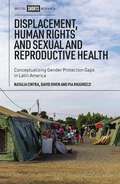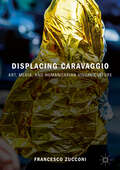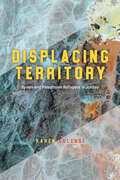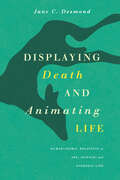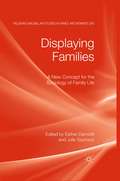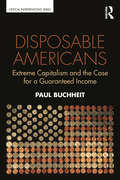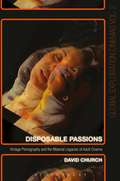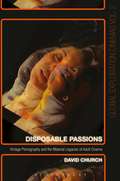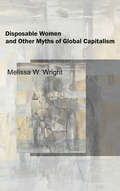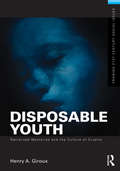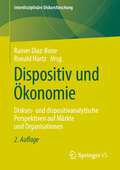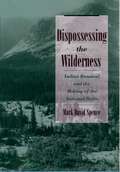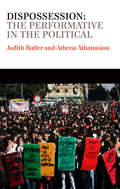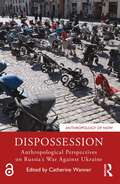- Table View
- List View
Displacement, Human Rights and Sexual and Reproductive Health: Conceptualizing Gender Protection Gaps in Latin America
by Natalia Cintra David Owen Pía RiggirozziFocusing on the flight of women and girls from Venezuela, this book examines the gendered nature of forced displacement and the ways in which the failures of protection regimes to be sensitive to displacement’s gendered character affect women and girls, and their sexual and reproductive health. Highlighting how categorical legal distinctions between ‘refugees’ and ‘migrants’ fail to capture the dynamics of forced migration in Latin America, it investigates how the operation of this categorical divide generates responsibility and protection gaps in relation to female forced migrants which act as determinants of sexual and reproductive health. Drawing on the voices of displaced women, it argues that a robust political ethics of protection of the forcibly displaced must encompass all necessary fleers and be responsive to the gendered character of forced displacement and particularly to effective access to sexual and reproductive health rights.
Displacing Caravaggio: Art, Media, and Humanitarian Visual Culture
by Francesco ZucconiThis book takes its start from a series of attempts to use Caravaggio’s works for contemporary humanitarian communications. How did his Sleeping Cupid (1608) end up on the island of Lampedusa, at the heart of the Mediterranean migrant crisis? And why was his painting The Seven Works of Mercy (1607) requested for display at a number of humanitarian public events? After critical reflection on these significant transfers of Caravaggio’s work, Francesco Zucconi takes Baroque art as a point of departure to guide readers through some of the most haunting and compelling images of our time. Each chapter analyzes a different form of media and explores a problem that ties together art history and humanitarian communications: from Caravaggio’s attempt to represent life itself as a subject of painting to the way bodies and emotions are presented in NGO campaigns. What emerges from this probing inquiry at the intersection of art theory, media studies and political philosophy is an original critical path in humanitarian visual culture.
Displacing Territory: Syrian and Palestinian Refugees in Jordan
by Karen CulcasiDisplacing Territory explores the core concepts of territory and belonging—and humanizes refugees in the process. Based on fieldwork with Palestinian and Syrian refugees in Jordan, Displacing Territory explores how the lived realities of refugees are deeply affected by their imaginings of what constitutes territory and their sense of belonging to different places and territories. Karen Culcasi shows how these individual conceptualizations about territory don’t always fit the Western-centric division of the world into states and territories, thus revealing alternative or subordinated forms and scales of territory. She also argues that disproportionate attention to “refugee crises” in the Global North has diverted focus from other parts of the world that bear the responsibility of protecting the majority of the world’s refugees. By focusing on Jordan, a Global South state that hosts the world’s second-largest number of refugees per capita, this book provides insights to consider alternate ways to handle the situation of refugees elsewhere. In the process, Culcasi brings the reader into refugees’ diverse realities through their own words, inherently arguing against the tendency of many people in the Global North to see refugees as aberrant, burdensome, or threatening.
Displacing Territory: Syrian and Palestinian Refugees in Jordan
by Karen CulcasiDisplacing Territory explores the core concepts of territory and belonging—and humanizes refugees in the process. Based on fieldwork with Palestinian and Syrian refugees in Jordan, Displacing Territory explores how the lived realities of refugees are deeply affected by their imaginings of what constitutes territory and their sense of belonging to different places and territories. Karen Culcasi shows how these individual conceptualizations about territory don’t always fit the Western-centric division of the world into states and territories, thus revealing alternative or subordinated forms and scales of territory. She also argues that disproportionate attention to “refugee crises” in the Global North has diverted focus from other parts of the world that bear the responsibility of protecting the majority of the world’s refugees. By focusing on Jordan, a Global South state that hosts the world’s second-largest number of refugees per capita, this book provides insights to consider alternate ways to handle the situation of refugees elsewhere. In the process, Culcasi brings the reader into refugees’ diverse realities through their own words, inherently arguing against the tendency of many people in the Global North to see refugees as aberrant, burdensome, or threatening.
Displaying Death and Animating Life: Human-Animal Relations in Art, Science, and Everyday Life (Animal Lives)
by Jane C. DesmondThe number of ways in which humans interact with animals is almost incalculable. From beloved household pets to the steak on our dinner tables, the fur in our closets to the Babar books on our shelves, taxidermy exhibits to local zoos, humans have complex, deep, and dependent relationships with the animals in our ecosystems. In Displaying Death and Animating Life, Jane C. Desmond puts those human-animal relationships under a multidisciplinary lens, focusing on the less obvious, and revealing the individualities and subjectivities of the real animals in our everyday lives. Desmond, a pioneer in the field of animal studies, builds the book on a number of case studies. She conducts research on-site at major museums, taxidermy conventions, pet cemeteries, and even at a professional conference for writers of obituaries. She goes behind the scenes at zoos, wildlife clinics, and meetings of pet cemetery professionals. We journey with her as she meets Kanzi, the bonobo artist, and a host of other animal-artists—all of whom are preparing their artwork for auction. Throughout, Desmond moves from a consideration of the visual display of unindividuated animals, to mourning for known animals, and finally to the marketing of artwork by individual animals. The first book in the new Animal Lives series, Displaying Death and Animating Life is a landmark study, bridging disciplines and reaching across divisions from the humanities and social sciences to chart new territories of investigation.
Displaying Death and Animating Life: Human-Animal Relations in Art, Science, and Everyday Life (Animal Lives)
by Jane C. DesmondThe number of ways in which humans interact with animals is almost incalculable. From beloved household pets to the steak on our dinner tables, the fur in our closets to the Babar books on our shelves, taxidermy exhibits to local zoos, humans have complex, deep, and dependent relationships with the animals in our ecosystems. In Displaying Death and Animating Life, Jane C. Desmond puts those human-animal relationships under a multidisciplinary lens, focusing on the less obvious, and revealing the individualities and subjectivities of the real animals in our everyday lives. Desmond, a pioneer in the field of animal studies, builds the book on a number of case studies. She conducts research on-site at major museums, taxidermy conventions, pet cemeteries, and even at a professional conference for writers of obituaries. She goes behind the scenes at zoos, wildlife clinics, and meetings of pet cemetery professionals. We journey with her as she meets Kanzi, the bonobo artist, and a host of other animal-artists—all of whom are preparing their artwork for auction. Throughout, Desmond moves from a consideration of the visual display of unindividuated animals, to mourning for known animals, and finally to the marketing of artwork by individual animals. The first book in the new Animal Lives series, Displaying Death and Animating Life is a landmark study, bridging disciplines and reaching across divisions from the humanities and social sciences to chart new territories of investigation.
Displaying Death and Animating Life: Human-Animal Relations in Art, Science, and Everyday Life (Animal Lives)
by Jane C. DesmondThe number of ways in which humans interact with animals is almost incalculable. From beloved household pets to the steak on our dinner tables, the fur in our closets to the Babar books on our shelves, taxidermy exhibits to local zoos, humans have complex, deep, and dependent relationships with the animals in our ecosystems. In Displaying Death and Animating Life, Jane C. Desmond puts those human-animal relationships under a multidisciplinary lens, focusing on the less obvious, and revealing the individualities and subjectivities of the real animals in our everyday lives. Desmond, a pioneer in the field of animal studies, builds the book on a number of case studies. She conducts research on-site at major museums, taxidermy conventions, pet cemeteries, and even at a professional conference for writers of obituaries. She goes behind the scenes at zoos, wildlife clinics, and meetings of pet cemetery professionals. We journey with her as she meets Kanzi, the bonobo artist, and a host of other animal-artists—all of whom are preparing their artwork for auction. Throughout, Desmond moves from a consideration of the visual display of unindividuated animals, to mourning for known animals, and finally to the marketing of artwork by individual animals. The first book in the new Animal Lives series, Displaying Death and Animating Life is a landmark study, bridging disciplines and reaching across divisions from the humanities and social sciences to chart new territories of investigation.
Displaying Death and Animating Life: Human-Animal Relations in Art, Science, and Everyday Life (Animal Lives)
by Jane C. DesmondThe number of ways in which humans interact with animals is almost incalculable. From beloved household pets to the steak on our dinner tables, the fur in our closets to the Babar books on our shelves, taxidermy exhibits to local zoos, humans have complex, deep, and dependent relationships with the animals in our ecosystems. In Displaying Death and Animating Life, Jane C. Desmond puts those human-animal relationships under a multidisciplinary lens, focusing on the less obvious, and revealing the individualities and subjectivities of the real animals in our everyday lives. Desmond, a pioneer in the field of animal studies, builds the book on a number of case studies. She conducts research on-site at major museums, taxidermy conventions, pet cemeteries, and even at a professional conference for writers of obituaries. She goes behind the scenes at zoos, wildlife clinics, and meetings of pet cemetery professionals. We journey with her as she meets Kanzi, the bonobo artist, and a host of other animal-artists—all of whom are preparing their artwork for auction. Throughout, Desmond moves from a consideration of the visual display of unindividuated animals, to mourning for known animals, and finally to the marketing of artwork by individual animals. The first book in the new Animal Lives series, Displaying Death and Animating Life is a landmark study, bridging disciplines and reaching across divisions from the humanities and social sciences to chart new territories of investigation.
Displaying Death and Animating Life: Human-Animal Relations in Art, Science, and Everyday Life (Animal Lives)
by Jane C. DesmondThe number of ways in which humans interact with animals is almost incalculable. From beloved household pets to the steak on our dinner tables, the fur in our closets to the Babar books on our shelves, taxidermy exhibits to local zoos, humans have complex, deep, and dependent relationships with the animals in our ecosystems. In Displaying Death and Animating Life, Jane C. Desmond puts those human-animal relationships under a multidisciplinary lens, focusing on the less obvious, and revealing the individualities and subjectivities of the real animals in our everyday lives. Desmond, a pioneer in the field of animal studies, builds the book on a number of case studies. She conducts research on-site at major museums, taxidermy conventions, pet cemeteries, and even at a professional conference for writers of obituaries. She goes behind the scenes at zoos, wildlife clinics, and meetings of pet cemetery professionals. We journey with her as she meets Kanzi, the bonobo artist, and a host of other animal-artists—all of whom are preparing their artwork for auction. Throughout, Desmond moves from a consideration of the visual display of unindividuated animals, to mourning for known animals, and finally to the marketing of artwork by individual animals. The first book in the new Animal Lives series, Displaying Death and Animating Life is a landmark study, bridging disciplines and reaching across divisions from the humanities and social sciences to chart new territories of investigation.
Displaying Death and Animating Life: Human-Animal Relations in Art, Science, and Everyday Life (Animal Lives)
by Jane C. DesmondThe number of ways in which humans interact with animals is almost incalculable. From beloved household pets to the steak on our dinner tables, the fur in our closets to the Babar books on our shelves, taxidermy exhibits to local zoos, humans have complex, deep, and dependent relationships with the animals in our ecosystems. In Displaying Death and Animating Life, Jane C. Desmond puts those human-animal relationships under a multidisciplinary lens, focusing on the less obvious, and revealing the individualities and subjectivities of the real animals in our everyday lives. Desmond, a pioneer in the field of animal studies, builds the book on a number of case studies. She conducts research on-site at major museums, taxidermy conventions, pet cemeteries, and even at a professional conference for writers of obituaries. She goes behind the scenes at zoos, wildlife clinics, and meetings of pet cemetery professionals. We journey with her as she meets Kanzi, the bonobo artist, and a host of other animal-artists—all of whom are preparing their artwork for auction. Throughout, Desmond moves from a consideration of the visual display of unindividuated animals, to mourning for known animals, and finally to the marketing of artwork by individual animals. The first book in the new Animal Lives series, Displaying Death and Animating Life is a landmark study, bridging disciplines and reaching across divisions from the humanities and social sciences to chart new territories of investigation.
Displaying Families: A New Concept for the Sociology of Family Life (Palgrave Macmillan Studies in Family and Intimate Life)
by Esther Dermott and Julie SeymourThis edited collection uses the concept of 'displaying families' as a new way to understand contemporary family and personal life, addressing how, in a world of fluid relationships, family life must not only be 'done' but also be 'seen to be done'.
Disposable Americans: Extreme Capitalism and the Case for a Guaranteed Income (Critical Interventions)
by Paul BuchheitInequality has dramatically increased in America, with few solutions on the horizon. Serious social inequalities persist. For example, the 14 richest Americans earned enough money from their investments in 2015 to hire two million preschool teachers (while the USA ranks low among developed countries in preschool enrollment). Following the Great Recession, the richest one percent took 116 percent of the new income gains, a statistic caused by so many middle-class Americans moving backward, many losing investments in property and experiencing interruptions in work. Author Paul Buchheit looks hopefully to solutions in a book that vividly portrays the rapidly changing inequality of American society. More Americans have become "disposable" as middle-class jobs have disappeared at an alarming rate. Buchheit presents innovative proposals that could quickly begin to reverse these trends, including a guaranteed basic income drawn from new revenues, such as a Financial Speculation Tax and a Carbon Tax. Discussing the challenges and obstacles to such measures, he finds optimism in past successes in American history. Ideal for classroom assignment, the book uniquely pairs historical events with current, real-life struggles faced by citizens, pointing to measures that can improve personal and social well-being and trust in government.
Disposable Americans: Extreme Capitalism and the Case for a Guaranteed Income (Critical Interventions)
by Paul BuchheitInequality has dramatically increased in America, with few solutions on the horizon. Serious social inequalities persist. For example, the 14 richest Americans earned enough money from their investments in 2015 to hire two million preschool teachers (while the USA ranks low among developed countries in preschool enrollment). Following the Great Recession, the richest one percent took 116 percent of the new income gains, a statistic caused by so many middle-class Americans moving backward, many losing investments in property and experiencing interruptions in work. Author Paul Buchheit looks hopefully to solutions in a book that vividly portrays the rapidly changing inequality of American society. More Americans have become "disposable" as middle-class jobs have disappeared at an alarming rate. Buchheit presents innovative proposals that could quickly begin to reverse these trends, including a guaranteed basic income drawn from new revenues, such as a Financial Speculation Tax and a Carbon Tax. Discussing the challenges and obstacles to such measures, he finds optimism in past successes in American history. Ideal for classroom assignment, the book uniquely pairs historical events with current, real-life struggles faced by citizens, pointing to measures that can improve personal and social well-being and trust in government.
Disposable Passions: Vintage Pornography and the Material Legacies of Adult Cinema (Global Exploitation Cinemas)
by David ChurchFrom early twentieth-century stag films to 1960s sexploitation pictures to the boom in 1970s “porno chic,” adult cinema's vintage forms are now being reappraised by a new generation of historians, fans, preservationists, and home video entrepreneurs-all of whom depend on and help shape the archive of film history. But what is the present-day allure of these artifacts that have since become eroticized more for their “pastness” than the explicit acts they show? And what are the political implications of recovering these rare but still-visceral films from a less “enlightened,” pre-feminist past? Drawing on media industry analysis, archival theory, and interviews with adult video personnel, David Church argues that vintage pornography retains its retrospective fascination precisely because these culturally denigrated texts have been so poorly preserved on political and aesthetic grounds. Through these films' ongoing moves from cultural emergence to concealment to rediscovery, the archive itself performs a “striptease,” permitting tangible contact with these corporeally stimulating forms at a moment when the overall physicality of media objects is undergoing rapid transformation. Disposable Passions explores the historiographic lessons that vintage pornography can teach us about which materials our society chooses to keep, and how a long-neglected genre is primed for serious rediscovery as more than mere autoerotic fodder.
Disposable Passions: Vintage Pornography and the Material Legacies of Adult Cinema (Global Exploitation Cinemas)
by David ChurchFrom early twentieth-century stag films to 1960s sexploitation pictures to the boom in 1970s “porno chic,” adult cinema's vintage forms are now being reappraised by a new generation of historians, fans, preservationists, and home video entrepreneurs-all of whom depend on and help shape the archive of film history. But what is the present-day allure of these artifacts that have since become eroticized more for their “pastness” than the explicit acts they show? And what are the political implications of recovering these rare but still-visceral films from a less “enlightened,” pre-feminist past? Drawing on media industry analysis, archival theory, and interviews with adult video personnel, David Church argues that vintage pornography retains its retrospective fascination precisely because these culturally denigrated texts have been so poorly preserved on political and aesthetic grounds. Through these films' ongoing moves from cultural emergence to concealment to rediscovery, the archive itself performs a “striptease,” permitting tangible contact with these corporeally stimulating forms at a moment when the overall physicality of media objects is undergoing rapid transformation. Disposable Passions explores the historiographic lessons that vintage pornography can teach us about which materials our society chooses to keep, and how a long-neglected genre is primed for serious rediscovery as more than mere autoerotic fodder.
Disposable Women and Other Myths of Global Capitalism
by Melissa WrightEveryday, around the world, women who work in the Third World factories of global firms face the idea that they are disposable. Melissa W. Wright explains how this notion proliferates, both within and beyond factory walls, through the telling of a simple story: the myth of the disposable Third World woman. This myth explains how young women workers around the world eventually turn into living forms of waste. Disposable Women and Other Myths of Global Capitalism follows this myth inside the global factories and surrounding cities in northern Mexico and in southern China, illustrating the crucial role the tale plays in maintaining not just the constant flow of global capital, but the present regime of transnational capitalism. The author also investigates how women challenge the story and its meaning for workers in global firms. These innovative responses illustrate how a politics for confronting global capitalism must include the many creative ways that working people resist its dehumanizing effects.
Disposable Women and Other Myths of Global Capitalism
by Melissa WrightEveryday, around the world, women who work in the Third World factories of global firms face the idea that they are disposable. Melissa W. Wright explains how this notion proliferates, both within and beyond factory walls, through the telling of a simple story: the myth of the disposable Third World woman. This myth explains how young women workers around the world eventually turn into living forms of waste. Disposable Women and Other Myths of Global Capitalism follows this myth inside the global factories and surrounding cities in northern Mexico and in southern China, illustrating the crucial role the tale plays in maintaining not just the constant flow of global capital, but the present regime of transnational capitalism. The author also investigates how women challenge the story and its meaning for workers in global firms. These innovative responses illustrate how a politics for confronting global capitalism must include the many creative ways that working people resist its dehumanizing effects.
Disposable Youth: Racialized Memories, and the Culture of Cruelty (Framing 21st Century Social Issues)
by Henry A. GirouxFacing a crisis unlike that of any other generation, young people are caught between the discourses of consumerism and a powerful crime-control-complex, and are viewed increasingly as commodities or are subjected to the dictates of an ever expanding criminal justice system. Drawing upon critical analyses, biography, and social theory, Disposable Youth explores the current conditions of young people now face within an emerging culture of privatization, insecurity, and commodification and raises some important questions regarding the role that educators, young people, and concerned citizens might play in challenging the plight of young people, while deepening and extending the promise of a better future and a viable democracy.
Disposable Youth: Racialized Memories, and the Culture of Cruelty (Framing 21st Century Social Issues)
by Henry A. GirouxFacing a crisis unlike that of any other generation, young people are caught between the discourses of consumerism and a powerful crime-control-complex, and are viewed increasingly as commodities or are subjected to the dictates of an ever expanding criminal justice system. Drawing upon critical analyses, biography, and social theory, Disposable Youth explores the current conditions of young people now face within an emerging culture of privatization, insecurity, and commodification and raises some important questions regarding the role that educators, young people, and concerned citizens might play in challenging the plight of young people, while deepening and extending the promise of a better future and a viable democracy.
Dispositiv und Ökonomie: Diskurs- und dispositivanalytische Perspektiven auf Märkte und Organisationen (Interdisziplinäre Diskursforschung)
by Rainer Diaz-Bone Ronald HartzDer in zweiter Auflage vorliegende Band bietet einen aktuellen Überblick über die Vielzahl neuerer sozialwissenschaftlicher Forschungen zur Bedeutung, Funktion und Theorie von Dispositiven in und für die Ökonomie. Denn die Ökonomie ist „instrumentiert“ – Organisationen und Märkte sind durchzogen und ausgestattet mit Objekten, Materialitäten, Technologien, Diskursen und Subjektivierungsweisen, deren spezifische Verknüpfungen die Ökonomie hervorbringen. Für die Analyse der Dispositive muss „Ökonomie“ daher notwendig transdisziplinär gefasst werden, gerade um die bisher weitgehende Ausblendung von Dispositiven in der Analyse von Märkten und Organisationen zu überwinden und diese durch neuartige theoretische aber auch vielfältige methodologische Zugänge zu erschließen. Diese Erschließung der materiellen und immateriellen Ausstattung der Ökonomie erfolgt nun nicht nur transdisziplinär, sondern auch international. Der Band präsentiert Beiträge von Forschenden aus Deutschland, Frankreich, Großbritannien und der Schweiz. Die durchgesehene und korrigierte Neuauflage wurde um eine Bibliographie neuerer Arbeiten ergänzt.
Dispossessing the Wilderness: Indian Removal and the Making of the National Parks
by Mark David SpenceNational parks like Yellowstone, Yosemite, and Glacier preserve some of this country's most cherished wilderness landscapes. While visions of pristine, uninhabited nature led to the creation of these parks, they also inspired policies of Indian removal. By contrasting the native histories of these places with the links between Indian policy developments and preservationist efforts, this work examines the complex origins of the national parks and the troubling consequences of the American wilderness ideal. The first study to place national park history within the context of the early reservation era, it details the ways that national parks developed into one of the most important arenas of contention between native peoples and non-Indians in the twentieth century.
Dispossessing the Wilderness: Indian Removal and the Making of the National Parks
by Mark David SpenceNational parks like Yellowstone, Yosemite, and Glacier preserve some of this country's most cherished wilderness landscapes. While visions of pristine, uninhabited nature led to the creation of these parks, they also inspired policies of Indian removal. By contrasting the native histories of these places with the links between Indian policy developments and preservationist efforts, this work examines the complex origins of the national parks and the troubling consequences of the American wilderness ideal. The first study to place national park history within the context of the early reservation era, it details the ways that national parks developed into one of the most important arenas of contention between native peoples and non-Indians in the twentieth century.
Dispossession: The Performative in the Political (Conversations #17)
by Judith Butler Athena AthanasiouDispossession describes the condition of those who have lost land, citizenship, property, and a broader belonging to the world. This thought-provoking book seeks to elaborate our understanding of dispossession outside of the conventional logic of possession, a hallmark of capitalism, liberalism, and humanism. Can dispossession simultaneously characterize political responses and opposition to the disenfranchisement associated with unjust dispossession of land, economic and political power, and basic conditions for living? In the context of neoliberal expropriation of labor and livelihood, dispossession opens up a performative condition of being both affected by injustice and prompted to act. From the uprisings in the Middle East and North Africa to the anti-neoliberal gatherings at Puerta del Sol, Syntagma and Zucchotti Park, an alternative political and affective economy of bodies in public is being formed. Bodies on the street are precarious - exposed to police force, they are also standing for, and opposing, their dispossession. These bodies insist upon their collective standing, organize themselves without and against hierarchy, and refuse to become disposable: they demand regard. This book interrogates the agonistic and open-ended corporeality and conviviality of the crowd as it assembles in cities to protest political and economic dispossession through a performative dispossession of the sovereign subject and its propriety.
Dispossession: The Performative in the Political (Conversations)
by Judith Butler Athena AthanasiouDispossession describes the condition of those who have lost land, citizenship, property, and a broader belonging to the world. This thought-provoking book seeks to elaborate our understanding of dispossession outside of the conventional logic of possession, a hallmark of capitalism, liberalism, and humanism. Can dispossession simultaneously characterize political responses and opposition to the disenfranchisement associated with unjust dispossession of land, economic and political power, and basic conditions for living? In the context of neoliberal expropriation of labor and livelihood, dispossession opens up a performative condition of being both affected by injustice and prompted to act. From the uprisings in the Middle East and North Africa to the anti-neoliberal gatherings at Puerta del Sol, Syntagma and Zucchotti Park, an alternative political and affective economy of bodies in public is being formed. Bodies on the street are precarious - exposed to police force, they are also standing for, and opposing, their dispossession. These bodies insist upon their collective standing, organize themselves without and against hierarchy, and refuse to become disposable: they demand regard. This book interrogates the agonistic and open-ended corporeality and conviviality of the crowd as it assembles in cities to protest political and economic dispossession through a performative dispossession of the sovereign subject and its propriety.
Dispossession: Anthropological Perspectives on Russia’s War Against Ukraine (Anthropology of Now)
by Catherine WannerThis volume examines Russia’s war on Ukraine. Scholars who have lived through the Russian invasion or who have conducted ethnographic research in the region for decades provide timely analysis of a war that will leave a lasting mark on the twenty-first century. Using the concept of dispossession, this volume showcases some of the novel ways violence operates in the Russian-Ukrainian war and the multiple means by which civilians, within the conflict zone and beyond, have become active participants in the war effort. Anthropological perspectives on war provide on-the-ground insight, historically informed analysis, and theoretical engagement to depict the experiences of dispossession by war and the motivations that drive the responses of the dispossessed. Such perspectives humanize the victims even as they depict the very inhumanity of war. Dispossession is geared towards upper-level undergraduate and graduate students, scholars, and the general reader who seeks to have a deeper understanding of the Russian-Ukrainian war as it continues to impact geopolitics more broadly.
